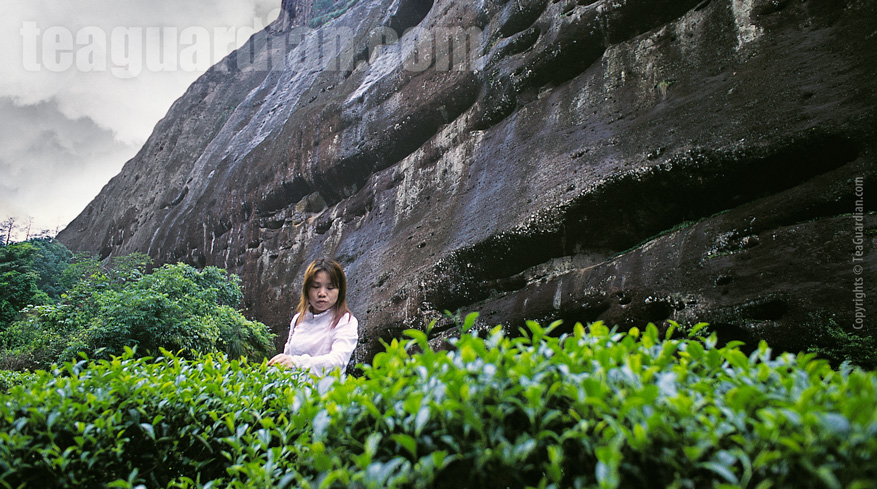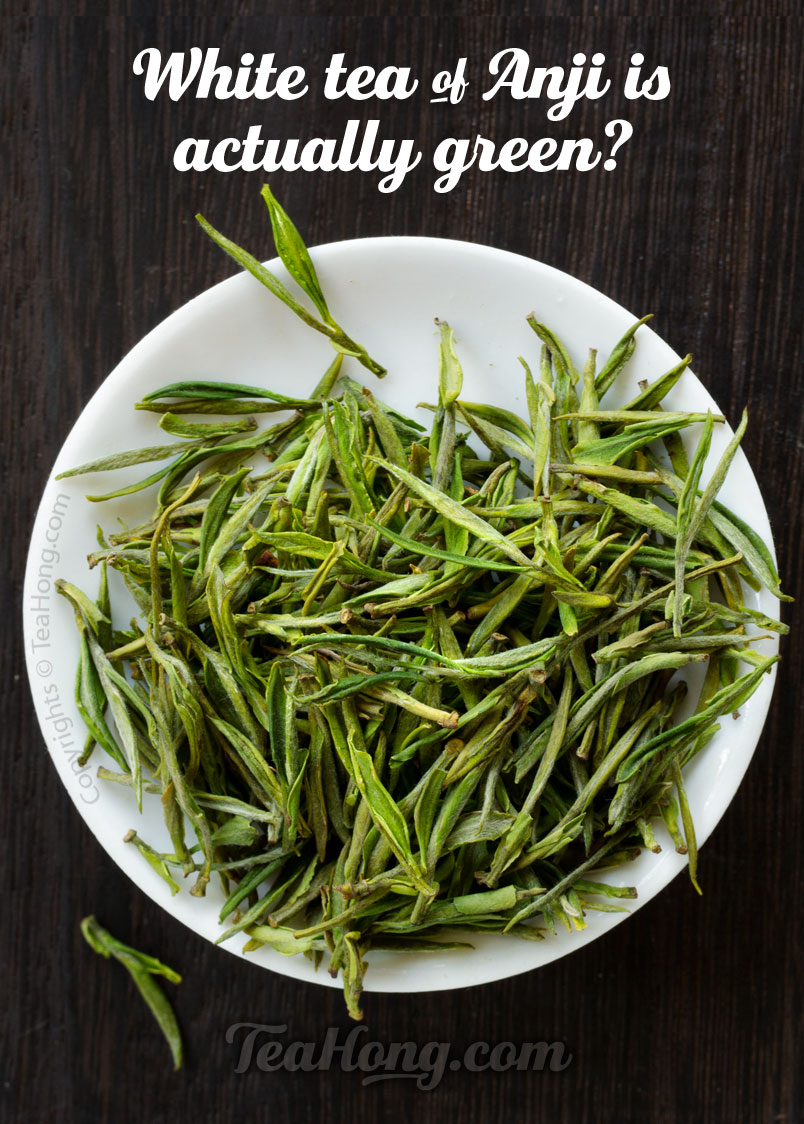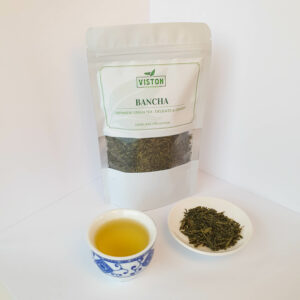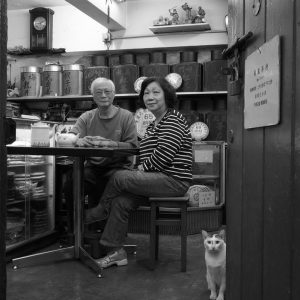Oolongs: Wuyi Varieties

A farm owner checking out the readiness of the shuixian new leaves under a rock near Tian Xin Yan, Wuyi
Wuyi (wǔ-yí) oolongs are a group of traditional oolongs produced in the Wuyi ( Wuyishan 武夷山 ) area in the northwestern border of Fujian Province, although all bordering counties are producing some sorts of similar teas that are sold under the same name.
Yancha, tea of the Rock
The varieties under this subcategory generally give a shorter, but more robust impression both in the aroma and in the taste, as compared with other oolongs. This has to do with how the plucks of the particular local cultivars are treated in the production style popularly adopted here — high fire and aggressively swift handling of the leaves.

Piling up the leaves for a last round of ‘fermentation’ during the zaoqing stage. Tea master Wang, a native in Wuyi, makes a donut shape of the pile for optimum heat dissipation during fermentation. 4:00 am. Traditional oolong production normally has the fermentation throughout the night because the tealeaves need proper sunning and resting before they can go through the zaoqing stage.
The finer productions are called Yancha 岩茶, i.e. teas of the big rocks, denoting origins that are in the heights rather than on the plains. The more difficult growing environment in the patches of land or steppes in the hills yield a lot more taste elements in the leaves, rather than just tannic and bitter “strength” of those from lower lands.
Amongst the Yancha, there are specially sought after ones that are from legendary cultivars, such as Da Hongpao (the Red Cloak), Tie Lohan (Iron Buddhist Monk, aka Iron Buddha), Bai Jiguan (White Crest of the Rooster), etc, etc. To certain people of status, access to such teas mean more status importance rather than the real gastronomic qualities.
Practical and fine quality selections come from other cultivars. The most popular is a group by the name of Shuixian (Water Goddess, aka Chinese Sacred Lily). Yes, you are right, the same name as that traditional cheap restaurant tea. Others include Rougui, Meijian, and other cultivars from Anxi, Taiwan, and Eastern Fujian, such as various strands of wulongs and Da’bai.
Like post-fermented teas and brown style Anxi, Wuyi oolongs are dinner table friendly and popular connoisseur’s choice in gongfu tea making.
firing up a neighbour’s plant
Wuyi is one of those UNESCO recognized natural heritage sites in China. It boosts of a scenic setting of hills made up largely of formidable dark rocks in a subtropical forest environment with a river of “nine bends” running through it.
The place had once been appointed by the imperial court as a supplier of compressed steamed green tea but its tea farms were completely got rid of because of heavy tea production tax (1) in the 1500’s. Around 1660’s migrants from southern Fujian introduced plants and techniques of oolong production in the area (2). The plants were of the same group as those in the Phoenix area in Guangdong province, immediately south of Fujian, by the name of Shuixian. It is likely that individual bushes had been transplanted a bit earlier in various nearby spots and successfully producing tiny batches for personal use. What really triggered a scale renaissance could have been the demand in export. Tea exported from Wuyi and nearby areas was known as Bohea, the “black tea” known to the West before red tea (known to the West as black tea today) was invented. Bohea is a translation of the Amoy dialect for Wuyi. <more about black tea history>
However, Wuyi oolongs are very different from those both in Anxi and Phoenix. Wuyi varieties are relatively strong, pungent, dry and short. This may be due to the differences in the biochemistry of the leaves as the plants adapted to the local environments. A larger cause, however, is the way oolong making has been adapted here.
selling it to the West
One of the earlier tea exported to the West was called Songlo (Songluo) (3), originally made in the famous Huangshan Mountains in Anhui province. A small batch of it could have been given to a visiting Dutch dignitary by a Chinese counterpart earlier. The tea was hip in China in the late 1500’s. By the beginning of the next century, tea plantation and a few skilled monks from Anhui were introduced to the deserted tea land in and around Wuyi, with the hope for some economic benefits, and likely aiming at the export trade — Wuyi was much closer to the inland waterways down to the export port of Guangzhou; while Huangshan was very isolated inland.
The way Songlo was made has a lot to do with the taste style of Wuyi — high fire is employed. Actually the residual influence is still seen in Huangshan Maofeng and Dinggu Dafang, both modern high fire green teas from the Huangshan area. Much lower fire is used in other oolong regions.

Tea buying in Wuyi 1790. Notice the three Westerners in the lower left corner of the painting in navy blue suits. The bending of the river is a stylized depiction of the Nine Bend River that is one key geographic feature of Wuyi. The tea chests are being loaded into river boats for a long and arduous land and waterway transport to the export port that is Guangzhou (Canton). Details from a painting by an unknown artist, possibly from one of the many production studios in Guangzhou making paintings for export. Excluded from this detail are more river bends and small dark rock mountains typical in Wuyi. This painting is in the collection of the Museum of the Massachusetts Institute of Technology.
This transplant of the fire style from this particular green tea production to Wuyi oolong happened because it was likely that the same group of labourers that were trained to do Songlo were taking part to make Wuyi. Zhou Lianggong, a much beloved local minister in the mid 1600’s, before the immigration of south Fujianese, wrote about Wuyi Songlo, “Tea is produced in mountains of Wuyi, but the monks are very poor in baking. They used to steam the plucked leaves before baking them, which made the tea purple red. That was why they were good only for washing in the imperial court. Recently the way of Songluo (roasting) was introduced, so the colour and aroma are fine, until a few months later, the tea turn purple red like before. The reason for that was because of the makers. They were only natives and a few monks who learned about the Songluo way through verbal instruction, which certainly has been distorted and simplified as it gets passed from one person to another…” (4) This is a clear documentation proving that the producers then did not bake deep into the leaves, leaving the moisture and perhaps residual enzymes in the green leaves to oxidize to that purple red colour, which was not unlike what people in Pu’er were doing with coarser leaves.
it hurts the lips but it sells
Zhou went on to write of Wuyi green tea in another chapter, “…Tea before First Spring Rain is good but the fire employed to process it was so high that people cannot even put the tea close to the lips (because the residual heat can make one sick). However, it can be stored till it turns to a dark red, when it can be sold for three times as much…” That is to say, there had already been a shallow but high fire tradition before the processing and plant varieties for oolong was introduced by southern Fujianese in the 1660’s or later. More about this in Minnan oolong chapter>
In the end, Wuyi did succeed in becoming a major production base for export tea, encompassing not only green, but also blacks and oolongs. Wuyi oolongs today remain quite unique as the oolong with the highest fire finish. Although moderate fire and greener styles are beginning to appear in recent years, but I have yet to see successful ones yet.












